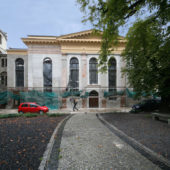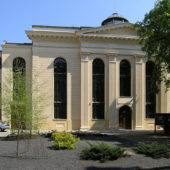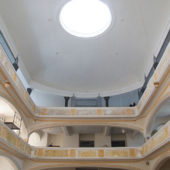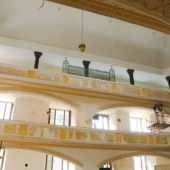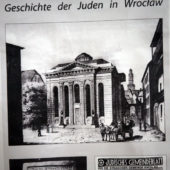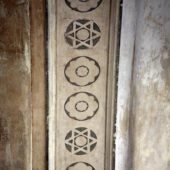Now being restored, this neo-classic structure has an art nouveau interior.
The White Stork Synagogue is a Conservative Synagogue with a tumultuous history. It is a Synagogue that has been emerging literally from the ashes as a Phoenix, as something grand and beautiful.
Wrocklaw is a unique city, located in southwest Poland. It has been governed by the Czechs, Poles, Austrians, Prussians, Germans and then finally, after WWII, the Poles. The first evidence of settlement in Wrocklaw dates back to 800 BC. and the city received its bishopric in 1000. The city’s medieval history and rich culture makes it unusual.
The Jewish community in Wrocklaw is one of the oldest in present day Poland. It was in evidence from the 12th century. This was due to the fact that Wrocklaw was an important trading hub, located on the Amber Track. It had free trade agreements with Prague, Venice and Karyntia. The life of the first Jewish community revolved around Jewish Street (present day Uniwersytecka), which is also where the first Jewish school and synagogue were built.
During the 15th century in Europe, anti-Semitism took a sharp increase, due to the Catholic Church and its anti-semitic teachings. In 1455 the Czech king Ladislav, roused by the preaching of J. Kapistran, granted Wrocklaw the rights privlegia de non tolerendis Judaeis. These basically stated that Jews who were involved in wholesale trade could only enter the town during fairs, and that during these, they must wear a distinguishing yellow patch on their clothes. This law was enforced for 200 years. In the 17th century, the Jewish community gradually grew again, due in large part to Zachary Lazarus from Nahod, who became the leaseholder of the town mint. Hasklaha swept the city in the second half of the 18th century and had many well-educated followers, which aided the Jews’ assimilation with their German neighbors. In the late 18th century Wilhelm School for Boys opened, following the teachings of Rabbi Abraham Geiger and the Orthodox teachings as led by Rabbi Gedalje Tiktin. This was the first school of its kind for boys in Wrocklaw. In 1812 a law was passed providing equal rights for all citizens, which further promoted growth of the Jewish community.
In 1829 the White Stork Synagogue was built, when the country was governed by Prussia. In 1871 Wrocklaw had the third largest Jewish community in Germany, after Berlin and Frankfurt. In the mid 19th century the novel Soll and Haben (Debit and Credit) by Gustav Freytag was published. This book was filled with anti-Semitic themes and between 1855-1922, was reprinted 113 times. Sadly, but not surprisingly, anti-Semitism in Wrocklaw once again became a problem. At the end of the 19th century and beginning of the 20th century a mass of impoverished Jews from arrived in Wrocklaw. The Wrocklaw Jews strongly defended the German character of its community. In the inter-war period, the Nazis won 40% votes from Wrocklaw and Lower Silesia. In April 1933 a boycott began. Jewish shops and property were visibly identified. In 1935 Nuremburg passed a law stating that Jews were total outcasts of society. In November of 1935 Jews were deprived of German citizenship and in 1938 they were no longer allowed to drive. On the Crystal Night (Kristallnacht) in November of 1938, 91 Jews were killed on the streets of Wrocklaw, and Jewish shops and property were demolished. The Synagogue was set ablaze. In 1945 the Synagogue’s destroyed interior was turned into a garage used as a Nazi warehouse, but by 1968, under communist rule, the Synagogue was nearly completely neglected and nearly entirely in ruins.
Approximately 8,000 citizens from Wrocklaw were exterminated in the Holocaust from 1941 to 1945. After WWII, Wrocklaw belonged once again to the Poles. Floods of Jews came through the city either to stay or on their way elsewhere, from the Soviet Union, as well as remnants of Polish Jews. In total, approximately 70,000 Jewish immigrants ended up settling in Wrocklaw after the war. At that time, there were four synagogues, a kosher canteen, a mikvah, a Talmud-Torah school, printing houses and two cemeteries. However, eventually the community began to dwindle as the Communist authorities began their anti-minorities campaign. What few Jews were left in Wrocklaw were expelled in 1968.
In 1972 the New (Neue) Synagogue was built and subsequently, the Jewish Theological Seminary was established. This was an important landmark for the Jewish community. In 1974 the authorities took over the White Stork Synagogue and gave it to the University of Wrocklaw, for use as a library. In 1989 the University decided to use the Synagogue as a Musical Academy. White Stork Synagogue was purchased in 1995, and given back to the Jewish people. Since that time, the Jewish community has once again been re-building itself in Wrocklaw around the White Stork Synagogue. The Synagogue has been undergone 14 years of extensive renovations, as funded in part, by the Bente Kahan Foundation. The photos on this website were taken in 2006, before completion of the restoration and a spectacular grand opening ceremony in 2010 to celebrate the re-opening of the Synagogue. The ceremonies were attended by illustrious guests from all over Europe including the Israeli Ambassador to Poland, the Chief Rabbi of Poland, the Chief Catholic Cardinal of Wroclaw, the Bishop of the Orthodox Church, and the President of the Union of Jewish Communities in Poland, as well as others from many faiths.
The famous German architect of this building is Carl Ferdinand Langhans Junior, who also designed Berlin’s Brandenburg Gate. This monumental three-story neoclassical edifice, features an arched window above the entrance and several elongated arched windows along every wall, to elegant effect. The original interior was designed by painter Raphael Biow and his son, Hermann Biow. However, the original interior was destroyed when the Nazis set fire to it in 1938. The largest prayer-hall is surrounded on three sides by upstairs balconies, used as the women’s galleries. The beautiful, carved wood Aron Kodesh sits against the East wall. The wood frame of the Aron Kodesh and the damaged tablets upon which are inscribed in Hebrew, The Ten Commandments, are the only original artifacts that were saved from the fire. Paned windows flank the sides of the room, with a large skylight in the center of the sanctuary. Since the renovation, there is now beautiful woodwork, lighting, seating, flooring, raised platform where the Aron Kodesh is located, and new windows. Originally, the Aron Kodesh was carved in Art Nouveau style, and some motifs with Stars-of David were found in an archway. Since the renovation, the styling is purely neoclassical.
Today, the Synagogue is not only used by the congregation for services, but it also serves the wider community. Because of its architectural beauty, outstanding acoustics and spacious seating, concerts, exhibitions, theatrical performances and workshops are held there. In May of 2010, White Storwk Synagogue became one of the most important architectural monuments in the city of Wrocklaw. The Synagogue is open for visitors to peruse, not only the Synagogue itself, but also the exhibition on the 800-year history of Wrocklaw and Lower Silesia. In 2001, the White Stork was the focus of an interesting documentary entitled, “From Kristallnacht to Crystal Day: A Synagogue in Wrocklaw Glows Again.” The film follows “the re-emergence of Jewish life in today’s post-communist Wroclaw, making the synagogue not only an historical monument but also a center and springboard for the continuity of the community.” This gives a good description of the importance of the Synagogue in the life of the community. There are presently 327 congregants that make up the Wrocklaw Jewish community at White Stork. The renovation of the synagogue has brought a real renovation in the life of the Jewish community in Wrocklaw.

